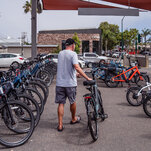
What Is an E-Bike, and How Safe Are They?
But Don’t Many E-Bikes Go Faster Than 20 M.P.H.?
Yes.
E-bikes are allowed to go faster than 20 m.p.h., and up to 28 in the case of a Class 3 bike, if the rider is pedaling while also using the motor.
But those limitations can, in many cases, be bypassed with little effort. For instance, some e-bikes are sold with speed “governors” that restrict the speed at the point of sale to 20 m.p.h. But that electronic governor can be eliminated by cutting a wire or changing the limitation with a smartphone app. Unrestricted, some models can exceed 55 m.p.h. Law enforcement officials and industry experts have said that e-bike manufacturers who sell these products are aware that the speed governors are regularly removed.
“Some products are sold as ostensibly compliant but are easily modified by the user with the knowledge and presumably the blessing of the manufacturer,” said Matt Moore, the general counsel for PeopleForBikes, the trade organization that represents bicycle and e-bike manufacturers. “The real question is what to do about it.”
What Is Being Done About This Loophole?
Good question, safety experts say.
“PeopleForBikes has been pointing out these issues to regulators for some time now,” Mr. Moore said. “Unfortunately, there appears to be a lack of resources at the federal level to investigate and address e-mobility products that may actually be motor vehicles.”
The federal government appears not to have a clear answer as to whether some of these products have ceased to be e-bikes — which are regulated by the Consumer Product Safety Commission, or C.P.S.C. — and instead have become motor vehicles, which are regulated by the National Highway Traffic Safety Administration.

